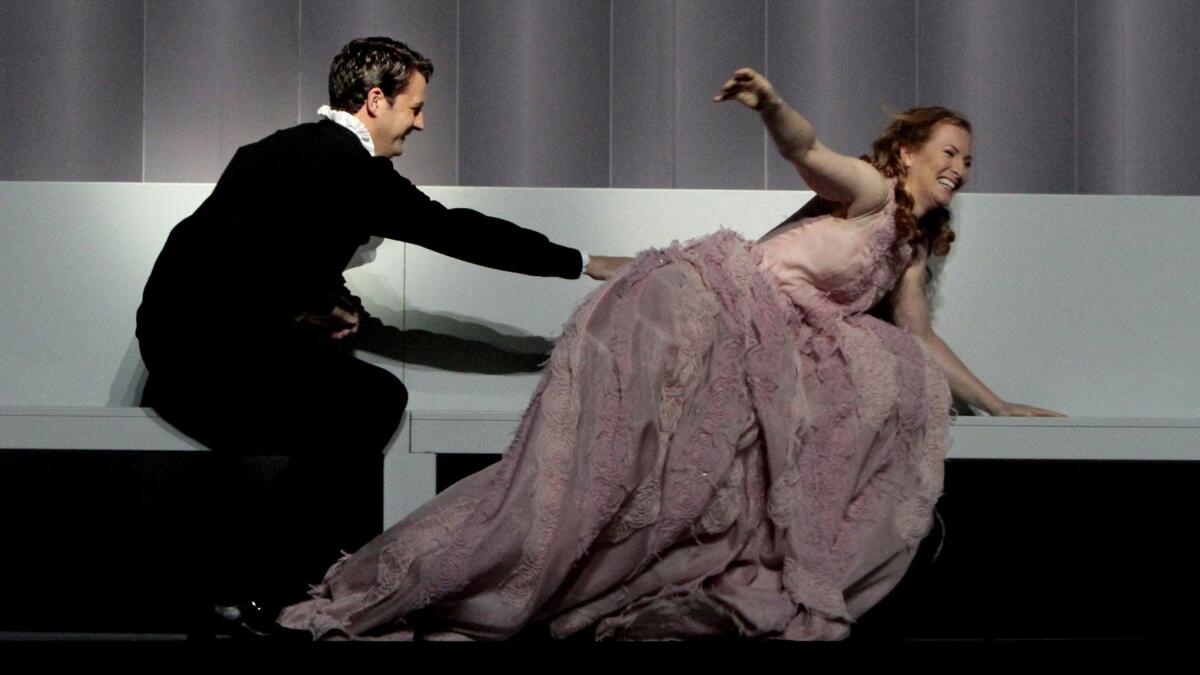L.A. Opera goes cutting edge in double bill of Purcell, Bartok

- Share via
Four cautious years after staging Achim Freyer’s cutting-edge but coffer-draining “Ring” cycle, Los Angeles Opera has once more sharpened its edge, and dangerously so. On Saturday night, it mounted a peculiar double bill of Purcell’s delicate “Dido and Aeneas” and Bartók’s indelicate “Bluebeard’s Castle.”
Purcell’s exquisite British Baroque miniature is as gorgeous to behold as anything the company has mounted on the Dorothy Chandler stage. It is lovingly performed. That the humor can be wicked and transgressive only makes the tragedy all the more touching in the end.
Bartók’s expressionist early 20th century drama is the unsettlingly awful opposite. There is nothing nice to look at, just a couple’s pain made plain. The performance is violent. What is here transgressive is that horror also makes a mass murderer somewhat touching in the end as well.
Cutting edge, indeed. Like those Japanese ceramic knives that lacerate careless fingers with startling ease, these dazzlingly physical productions by provocative Australian director Barrie Kosky are exercises in surgically slicing through vital skin. “Dido” offers sumptuous surfaces. “Bluebeard” is an open wound let fester onstage.
Last season, Kosky put up a good front. In his U.S. debut, he mounted for L.A. Opera a beguiling production of Mozart’s “The Magic Flute” with magical cinematic effects redolent of the silent film era. It was loved by young and old. But the other side of Kosky, who heads Berlin’s traditionally incendiary Komische Oper, is that of a fastidious butcher of the psyche.
Kosky’s “Dido” operates on the pleasure principle. The opera takes place on a long white bench on the lip of the stage, with a crenulated wall behind, which happens to serve as an excellent acoustic shell. A period-style orchestra is in a pit raised almost to stage level. The strings come from the L.A. Opera orchestra; the wind instruments, theorbos (long-necked lutes) and keyboards are handled by period-instrument specialists.
Katrin Lea Tag’s terrific costumes, 21st century takes on late 17th- and early 18th-century court couture, are an important element. They and the singers wearing them are also the set. When a mountain is needed, the chorus makes one out of its bodies.
There is much anachronistic weirdness for Kosky’s telling of the romance of Carthage’s queen and the Trojan prince who leaves her as he heads off to found ancient Rome. Mezzo-soprano Paula Murrihy’s stately Dido is gowned in a wide pannier of yore. Baritone Liam Bonner’s bounding Aeneas is more the lounge singer from a Las Vegas of yore, creating a kind of Dido and Dino.
The cross-dressing sorceress and witches, who connive to send Aeneas on his way, are scene-stealers. John Holiday, G. Thomas Allen and Darryl Taylor are advertised as the first trio of African American countertenors to appear together in an opera production. They wear flowing black gowns. Holiday, a large man, also dons a frilly white dress, which he removes and does a kick step. Make what you will of it. (The production originated at Frankfurt Opera, where the role was conceived for a reed-thin countertenor.) But this is a trio of vibrant, flexible, funny Baroque singers who might have a road show of their own in their future.
Some movement is excessive. As Dido’s sister, Belinda, soprano Kateryna Kasper twitches in time to instrumental ornamentations that sound like the music of nervous ticks. But every instant of the hour-long opera is a stage picture. A semi-nude couple in white paint and large feather headpieces adds to the look.
Although best known for his performances of contemporary music, Steven Sloane conducts the period instruments and the modern singers with a convincing sense of styles suited for both eras.
“Bluebeard” is another world. The full stage is bare but for an angled, slowly rotating disc. A large modern orchestra is sunk into a deep pit.
Bluebeard and his new wife, Judith, are a middle-aged couple in modern dress. Judith entices Bluebeard to open seven mysterious locked doors of his spooky castle. Here, they become the psychotic doors of Bluebeard’s perception.
The horrors found in the castle are the horrors internalized in his body. His garden, gold and the tears of his tortured previous wives all flow from him. His limbs release bodily fluids; vines flow from his arms; gold dust pours out of his sleeves.
He twitches and trembles like a Belinda on steroids. Judith tries to save him, twitching and trembling a good deal herself. Kosky brings out three more couples that appear as shadows of Bluebeard and Judith. Judith will be the fourth wife Bluebeard will murder.
There is a robustness and majesty to “Bluebeard,” thanks to Bartók’s magnificent score, which unearths many levels of meaning. With nothing onstage, this production, however, becomes a perverse study in claustrophobia, further enhanced by Joachim Klein’s stark lighting.
Baritone Robert Hayward and mezzo-soprano Claudia Mahnke spend an hour in a kind of mutual Rolfing session, she physically trying to release his demons. They cannot, in these circumstances, make pretty sounds, and both are necessarily monochromatic. At Sloane’s coaxing, the orchestra provides the necessary color.
In the program notes, Kosky comes up with connections between the operas — approaches to departure and arrival, to the dynamics of lovers, to the concept of a lost Eden, across centuries. But onstage, it’s the approach to demons that proves the most telling.
Purcell’s Aeneas can blame the silly witches and go off and be a hero without having to take responsibility for the resulting death of a distraught Dido. With no mythology left for blame, Bartók’s 20th-century Bluebeard destroys himself and four wives with him.
Welcome back to the big time, L.A. Opera.
Twitter: @markswed
---------------------------
‘Dido and Aeneas’ and ‘Bluebeard’s Castle’
Where: Dorothy Chandler Pavilion, Los Angeles
When: 2 p.m. Sunday and Nov. 9, 7:30 p.m. Nov. 6, 12 and 15
Cost: $17 to $298
Info: (213) 972-8001 or https://www.laopera.org
Running time: 2 hours, 30 minutes
More to Read
The biggest entertainment stories
Get our big stories about Hollywood, film, television, music, arts, culture and more right in your inbox as soon as they publish.
You may occasionally receive promotional content from the Los Angeles Times.











